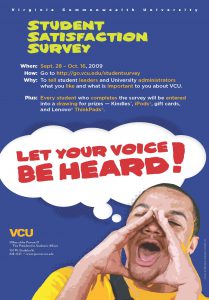student success
Campus case study: Virginia Commonwealth University
Like many large institutions, Virginia Commonwealth University (VCU) was a much-surveyed campus community – so much so, in fact, that the proliferation of ad hoc, piecemeal assessments had created a kind of survey fatigue, with few strategic results, says Kelli Parmley, assistant vice provost at VCU’s Center for Institutional Effectiveness. “I was looking for an opportunity to be more strategic at the institutional level with our surveys,” says Parmley, who was also eyeing the institution’s next accreditation process five years out. But it was a pointed question from a board member that spurred VCU to find a more effective approach.
“There’s nothing like a board member asking, ‘Overall, how do students feel about VCU?’” she recalls. “With all our surveys, we couldn’t answer that.”
“There’s nothing like a board member asking, ‘Overall, how do students feel about VCU?’ …With all our surveys, we couldn’t answer that.”
With three months to find a preliminary answer in time for the fall board meeting, Parmley convened an advisory group representing the array of VCU departments and schools that deployed surveys or were consumers of survey information – students affairs, academic affairs, enrollment services, parking and safety, along with representatives from VCU’s medical campus. The group moved quickly to share information about the welter of surveys currently in use, agreed to a campus-wide moratorium on existing surveys, and – after studying a handful of national higher education surveys – recommended that the campus employ the Noel-Levitz Student Satisfaction Inventory (SSI) to survey its undergraduate students and Adult Student Priorities Survey (ASPS) for its graduate and professional students. Both instruments are designed to measure student satisfaction with diverse aspects of academic and campus life and indicate the importance of each of these areas to students, providing a roadmap for institutional planning and action.
Choosing a web-based approach over a pencil-and-paper survey, VCU worked with Noel-Levitz to deploy the surveys online through the institution’s student portal. “It was very sophisticated,” says Parmley. “When a student logged on, the portal would recognize whether the student was an undergraduate or graduate student and link them to the right survey.”

Parmley also enlisted the help of the campus communication office to develop a multi-pronged plan to build campus support and encourage student participation. It began with an e-mail letter from VCU’s president to all students, inviting them to participate and providing a link to the survey. Student leaders were engaged to send a series of e-mails encouraging participation. “We created cool posters that said, ‘Let your voice be heard!’ and offered more than 60 incentive prizes – things like laptops, Kindles and iPods – to those who participated.”
Mid-survey, staff extracted data and checked response rates relative to the student population to determine whether participation was representative, Parmley explains. “We looked carefully at school-level responses, and if they were low in a given area, we went back to the school and did additional communication to encourage participation so the results would be valuable for that school.”
Shining a spotlight on key areas
VCU’s efforts were rewarded with a 25 percent participation rate among undergraduates and an even more impressive 30 percent participation rate among grad students. Parmley credits the communication plan – “multiple messages presented in multiple ways” – and the use the portal as being critical factors.
“The survey pointed us in directions that we explored further through student focus groups, and we learned some very important things”
The survey revealed positives that could be capitalized on, such as student perceptions that VCU – the most diverse among the state’s public research universities – has a strong commitment to racial harmony. It also revealed performance gaps in areas such as advising and enrollment services. “The survey pointed us in directions that we explored further through student focus groups, and we learned some very important things,” Parmley says.
While presenting preliminary data to VCU’s board, Parmley worked with Noel-Levitz to create a more in-depth analysis of the data and begin relating it to VCU’s strategic plan. “The value in conducting and using the survey isn’t so much in any one actual score,” she emphasizes. “It’s in the ability to focus on a few key areas for improvement. That takes time and commitment, and this has been my best experience of this at VCU.” She says the institution-wide surveys have helped VCU better understand the relationship – and the balance needed – between in-class outcomes and the out-of-class experience that includes areas such as advising, course availability, and student activities.
Parmley plans to repeat the survey in three years. “When people see how the survey results can be used to positively affect change,” she says, “there will be ongoing support for assessment.”